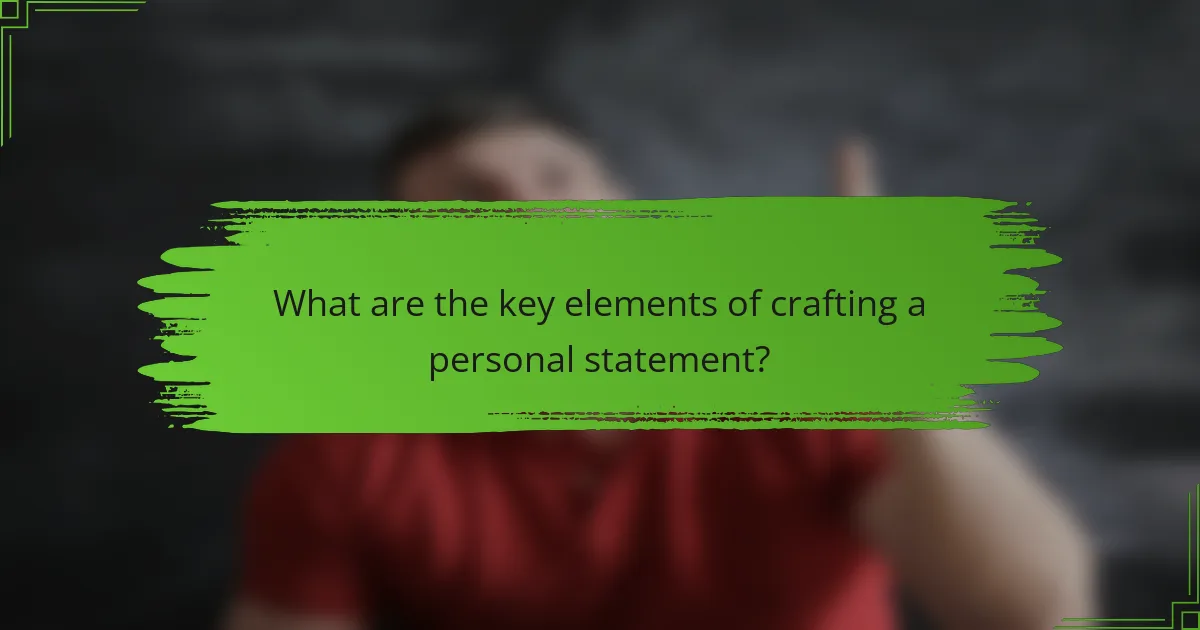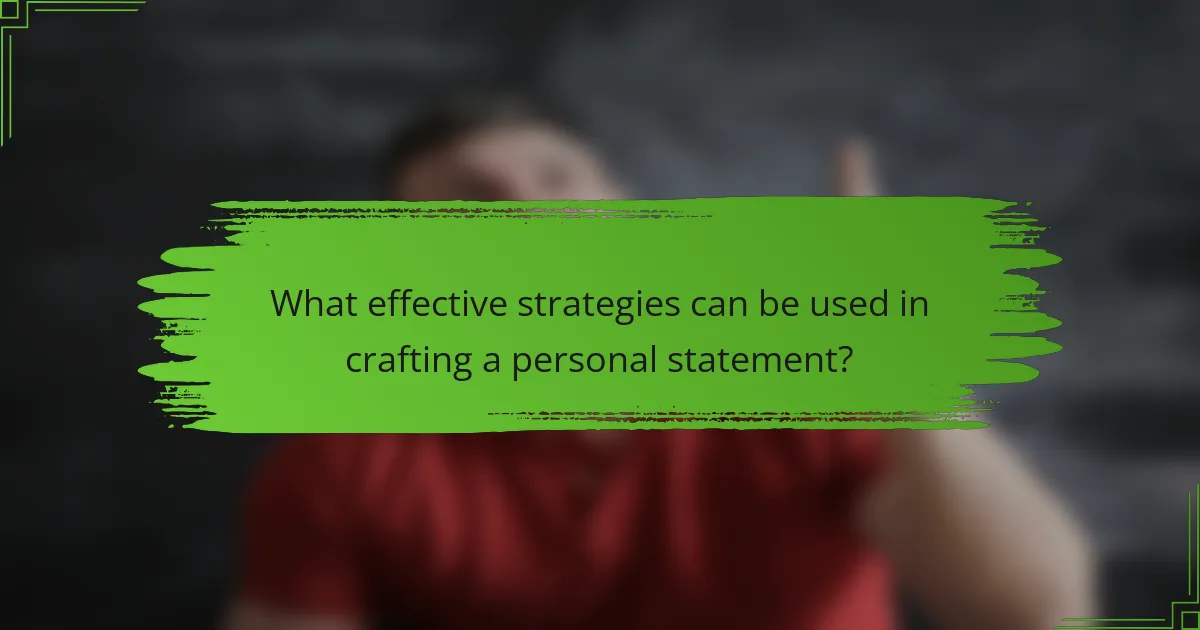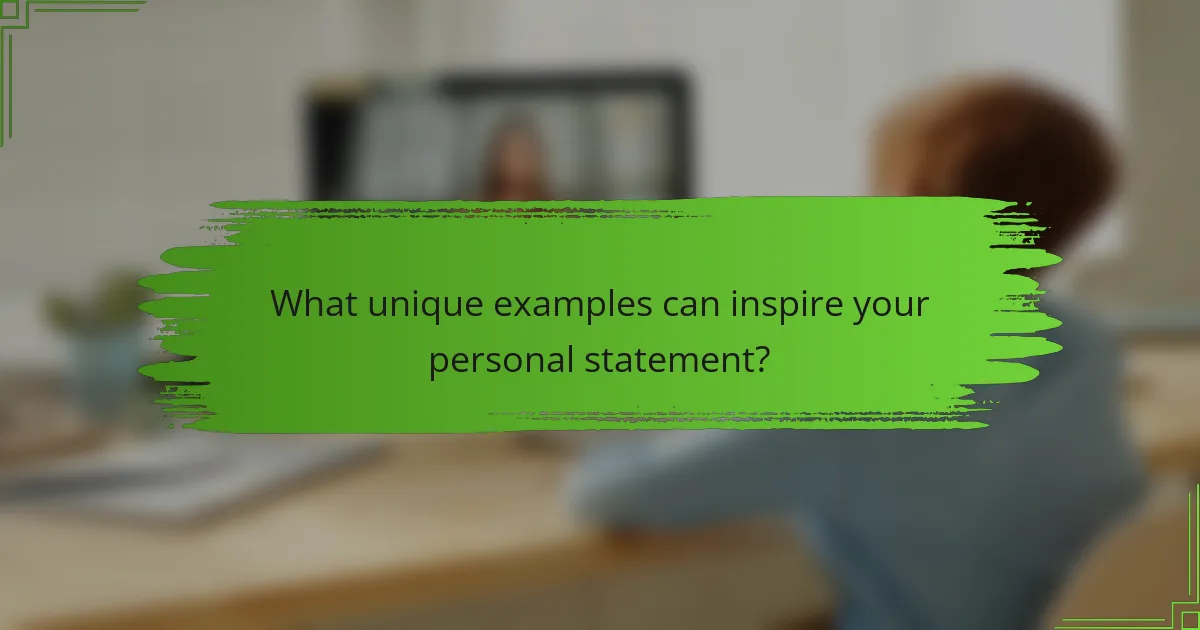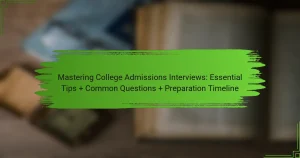
What are the key elements of crafting a personal statement?
The key elements of crafting a personal statement include clarity, authenticity, and structure. Clarity ensures that your message is easily understood. Authenticity reflects your true self and experiences. Structure organizes your thoughts logically. Each element plays a vital role in engaging the reader. A well-structured statement typically includes an introduction, body, and conclusion. The introduction should capture attention and present your main theme. The body elaborates on your experiences and motivations. The conclusion reinforces your key points and leaves a lasting impression. These elements collectively enhance the effectiveness of your personal statement.
How do personal statements differ across various applications?
Personal statements differ in focus and requirements based on the application type. For college applications, personal statements often emphasize academic achievements and future goals. In contrast, job applications may require statements that highlight professional experience and skills relevant to the position. Graduate school applications typically ask for a deeper exploration of research interests and academic motivations. Each application type has specific prompts that guide the content and tone of the personal statement. Colleges may seek personal stories that demonstrate character and resilience. Job applications might prioritize concise, results-oriented language. Graduate programs often value analytical thinking and passion for the field. These differences reflect the distinct objectives of each application process.
What common components should be included in a personal statement?
A personal statement typically includes several common components. These components are an introduction, academic background, personal experiences, career goals, and a conclusion. The introduction should capture the reader’s attention and provide a brief overview of the applicant’s motivation. The academic background outlines relevant education and achievements. Personal experiences highlight significant life events or challenges that shaped the applicant. Career goals should clearly articulate future aspirations and how the program aligns with them. Finally, the conclusion summarizes the key points and reinforces the applicant’s enthusiasm. These components work together to create a comprehensive narrative that showcases the applicant’s qualifications and character.
How does the audience influence the content of a personal statement?
The audience significantly influences the content of a personal statement. Understanding the audience helps tailor the message to their expectations. For example, academic institutions look for specific qualities in applicants. These may include leadership, resilience, and academic achievements. Therefore, applicants should highlight relevant experiences that showcase these traits. Additionally, the tone and language should align with the audience’s preferences. A formal tone may be appropriate for academic audiences, while a more personal tone may suit creative fields. Ultimately, aligning content with audience expectations enhances the effectiveness of the personal statement.
Why is storytelling important in a personal statement?
Storytelling is important in a personal statement because it engages the reader and conveys personal experiences. It allows the writer to illustrate their journey, motivations, and values. A compelling story can make the statement memorable and relatable. Personal narratives help to humanize the applicant, showcasing unique qualities and perspectives. According to research published in the Journal of Educational Psychology, storytelling enhances memory retention and emotional connection, making the content more impactful. This emotional resonance can influence admissions decisions positively.
What techniques can enhance storytelling in personal statements?
Using vivid imagery enhances storytelling in personal statements. This technique allows readers to visualize experiences. Descriptive language engages emotions and creates a connection. Personal anecdotes provide authenticity and relatability. They illustrate unique experiences that shaped the individual. A clear narrative structure aids comprehension. It guides readers through the journey effectively. Showing vulnerability can deepen emotional impact. It invites empathy and understanding from the audience.
How can personal experiences shape the narrative of a personal statement?
Personal experiences significantly shape the narrative of a personal statement. They provide authenticity and a unique perspective. Personal stories illustrate motivation and passion for the chosen field. Specific experiences can highlight resilience, growth, and learning. For example, overcoming challenges can demonstrate determination and commitment. These narratives create emotional connections with the reader. They also differentiate the applicant from others with similar qualifications. A well-crafted personal statement reflects individuality through personal experiences.

What effective strategies can be used in crafting a personal statement?
Effective strategies for crafting a personal statement include clear self-reflection, structured organization, and authentic storytelling. Self-reflection helps identify personal values and goals. This clarity allows for a focused narrative. Structuring the statement with a compelling introduction, body, and conclusion enhances readability. Authentic storytelling engages the reader and showcases individuality. Using specific examples illustrates achievements and experiences. Tailoring the content to the intended audience demonstrates relevance. Revising and seeking feedback improves clarity and impact. These strategies collectively enhance the overall effectiveness of the personal statement.
How can one create a strong opening for a personal statement?
To create a strong opening for a personal statement, start with a compelling hook. This could be an intriguing question, a personal anecdote, or a striking fact. Engaging the reader immediately sets the tone for the rest of the statement. Following the hook, provide context that relates to your goals and experiences. This connection demonstrates relevance and personal insight. Research shows that personal stories can increase engagement, as they evoke emotional responses. A well-crafted opening not only captures attention but also establishes a personal connection with the reader.
What techniques can grab the reader’s attention from the start?
Engaging the reader from the start can be achieved through several techniques. One effective method is to use a captivating hook, such as a surprising fact or a thought-provoking question. This immediately piques interest and encourages further reading. Another technique is to share a personal anecdote that relates to the main theme, creating an emotional connection with the reader.
Starting with a bold statement can also grab attention by challenging common beliefs or assumptions. Utilizing vivid imagery in the opening lines helps paint a picture that draws readers in. Additionally, presenting a relevant quote can lend authority and intrigue to the statement.
Research indicates that openings that elicit curiosity tend to be more effective. According to a study by the University of California, Berkeley, engaging openings increase reader retention and interest. These techniques collectively enhance the likelihood of capturing the reader’s attention effectively.
Why is it important to establish a clear thesis in the introduction?
Establishing a clear thesis in the introduction is crucial for guiding the reader’s understanding. A well-defined thesis provides a roadmap for the entire document. It helps to focus the content and argumentation. This clarity allows readers to anticipate the main points that will be discussed. Studies show that essays with clear theses are more persuasive and coherent. A clear thesis also enhances the writer’s focus, ensuring that all subsequent content supports the main argument. This alignment between thesis and content improves overall effectiveness and engagement.
What role does revision play in developing a personal statement?
Revision is crucial in developing a personal statement. It allows for the refinement of ideas and clarity of expression. Through revision, writers can identify and eliminate unnecessary content. This process enhances the overall coherence of the statement. Additionally, revision helps to ensure the alignment of the statement with application requirements. Feedback during revision can provide new perspectives and insights. Ultimately, revision improves the quality and impact of the personal statement. Research shows that multiple drafts lead to stronger writing outcomes.
How can feedback improve the quality of a personal statement?
Feedback can significantly enhance the quality of a personal statement. It provides an external perspective on clarity and coherence. Reviewers can identify areas of strength and weakness within the statement. Constructive criticism helps refine ideas and improve overall structure. Feedback can also highlight grammatical errors that the writer may overlook. This process encourages the writer to articulate their experiences more effectively. Research indicates that peer review improves writing quality by 30% on average. Engaging with feedback ultimately leads to a more polished and impactful personal statement.
What are the best practices for revising a personal statement?
The best practices for revising a personal statement include multiple steps. First, review the statement for clarity and coherence. Ensure that each paragraph flows logically to the next. Second, check for grammatical errors and typos. These mistakes can detract from the professionalism of the statement. Third, seek feedback from peers or mentors. External perspectives can highlight areas for improvement. Fourth, ensure that the personal statement aligns with the specific requirements of the program or institution. Tailoring the content demonstrates attention to detail. Fifth, read the statement aloud. This practice can help identify awkward phrasing or unclear sentences. Lastly, allow time between revisions. Distance can provide new insights during the editing process.

What unique examples can inspire your personal statement?
Unique examples that can inspire your personal statement include personal challenges, transformative experiences, and unique accomplishments. Personal challenges, such as overcoming adversity, showcase resilience and determination. Transformative experiences, like studying abroad or volunteering, highlight personal growth and cultural awareness. Unique accomplishments, such as leading a project or winning an award, demonstrate leadership and initiative. These examples provide concrete evidence of your character and aspirations. They can effectively illustrate your journey and motivations, making your personal statement compelling.
How can examples from successful personal statements guide your writing?
Examples from successful personal statements can significantly enhance your writing by providing clear models of effective structure and tone. They illustrate how to articulate personal experiences and motivations compellingly. Analyzing these examples helps identify key elements such as storytelling, clarity, and authenticity. Successful statements often demonstrate how to connect personal narratives to broader themes, making them relatable. They also showcase the importance of engaging openings and strong conclusions. By examining the language and style used, writers can adopt techniques that resonate with admissions committees. Furthermore, these examples reveal common pitfalls to avoid, such as clichés or overly complex language. Overall, successful personal statements serve as practical guides for crafting a unique and impactful narrative.
What are notable themes found in effective personal statements?
Notable themes in effective personal statements include personal growth, motivation, and unique experiences. Personal growth reflects the applicant’s journey and learning. Motivation highlights the reasons for pursuing a specific field or opportunity. Unique experiences showcase distinct aspects of the applicant’s background. These themes create a compelling narrative. They help admissions committees understand the applicant’s individuality. Additionally, effective personal statements often demonstrate resilience and adaptability. These qualities strengthen the applicant’s profile. Overall, these themes contribute to a well-rounded and memorable personal statement.
How do different fields showcase individuality in personal statements?
Different fields showcase individuality in personal statements through unique themes and personal experiences. For instance, in creative fields, applicants often emphasize artistic journeys and personal inspirations. They may include anecdotes about pivotal moments that shaped their creative vision. In scientific disciplines, candidates might focus on research experiences and problem-solving skills. They often highlight specific projects or experiments that demonstrate their analytical abilities.
Business applicants typically showcase leadership experiences and entrepreneurial initiatives. They may discuss specific challenges they overcame in team settings. In education, candidates often reflect on their teaching philosophies and impactful interactions with students. Each field encourages applicants to align their personal narratives with relevant experiences. This alignment helps to illustrate their individuality effectively.
What common pitfalls should be avoided when writing a personal statement?
Common pitfalls to avoid when writing a personal statement include vague language, excessive jargon, and lack of focus. Vague language makes it hard for readers to understand the applicant’s message. Using excessive jargon can alienate readers who may not be familiar with specific terms. A lack of focus leads to a disorganized statement that fails to convey the applicant’s key strengths. Additionally, failing to tailor the statement to the specific program or opportunity can result in a generic submission. Overly emotional language can detract from professionalism. Lastly, neglecting to proofread can lead to errors that diminish credibility. Each of these pitfalls can significantly impact the effectiveness of a personal statement.
How can clichés undermine the impact of a personal statement?
Clichés can undermine the impact of a personal statement by making it sound generic and unoriginal. When statements are filled with overused phrases, they fail to convey an applicant’s unique voice. Admissions committees often read numerous personal statements. Clichés can cause an applicant’s statement to blend in rather than stand out. This lack of originality can lead to a perception of a lack of effort or self-reflection. Additionally, clichés may dilute the emotional weight of a statement. They can prevent the conveyance of genuine experiences and insights. Ultimately, avoiding clichés helps create a more compelling narrative that captures attention.
What are the consequences of being overly vague or general?
Being overly vague or general can lead to misunderstandings and misinterpretations. Clarity is essential in communication, especially in personal statements. When statements lack specificity, they fail to convey the intended message. This can result in the audience losing interest or not grasping the core message. Specific examples and details engage readers and enhance credibility. Research indicates that clear and concise communication improves comprehension and retention. For instance, a study from the Journal of Communication found that specific information increases audience engagement. Therefore, vague language can diminish the impact of personal statements.
What practical tips can enhance the effectiveness of your personal statement?
To enhance the effectiveness of your personal statement, focus on clarity and authenticity. Begin with a strong opening that captures attention. Clearly outline your motivations and goals. Use specific examples to illustrate your experiences. Tailor your statement to the program or institution you are applying to. Maintain a consistent tone and style throughout the document. Proofread for grammar and clarity to avoid errors. Seek feedback from mentors or peers for additional perspectives. These strategies can significantly improve the impact of your personal statement.
The main entity of this article is the personal statement, a crucial component in various applications such as college admissions, job applications, and graduate school. The article outlines key elements for crafting an effective personal statement, including clarity, authenticity, and structure, while emphasizing the importance of storytelling and audience awareness. It also provides practical strategies for writing, revising, and tailoring personal statements, as well as common pitfalls to avoid. Unique examples and notable themes are discussed to inspire applicants and enhance the overall quality of their narratives.




